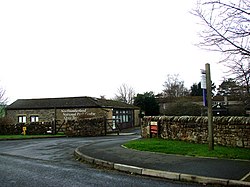Twice Brewed
| Twice Brewed or Once Brewed | |
| Northumberland | |
|---|---|
 National Park Centre at Once Brewed | |
| Location | |
| Grid reference: | NY751669 |
| Location: | 54°59’46"N, 2°23’22"W |
| Data | |
| Post town: | Hexham |
| Postcode: | NE47 |
| Local Government | |
| Council: | Northumberland |
| Parliamentary constituency: |
Hexham |
Twice Brewed, also known as Once Brewed, is a hamlet in Northumberland, very close to Hadrian's Wall, which runs just a few hundred yards to the north. The Vindolanda Roman Fort is just to the southeast of Twice Brewed.
The hamlet is found along on the B6318 ("the Military Road"), and is mainly known for its Youth Hostel, the earliest in the land, which has accommodated many an expedition in the Cheviots over the years and the Roman fort.
Location
The village consists of the Twice Brewed inn, a YHA youth hostel and a visitor centre to the Northumberland National Park, and also some farms. One of the farms to the west is called "West Twice Brewed".
Both the Twice Brewed Inn and the youth hostel are popular sleeping places for walkers on the Hadrian's Wall Path and the Pennine Way.
Name
This place was once known unambiguously as "Twice Brewed", which was the name of a pub on the road. Maps from before the Great War do not show a name for the particular location, but do mark farmsteads east and west of the junction of lanes as "East Twice Brewed" and "West Twice Brewed". The name of the inn goes back centuries, and its origin is the subject of many stories, many or all apparently invented as flights of fancy.
In 1934, Lady Trevelyan founded the hostel here; the first youth hostel in the land. A keen teetotaller, Lady Trevelyan asserted that "We shall serve nothing stronger than tea, and I hope that even that will be only once brewed". The hostel therefore became known as the Once Brewed Youth Hostel.
The Twice Brewed Inn preceded the Once Brewed Youth Hostel, and together they provide the dual name of the village: a motorist arriving over the B6138 from the east will see the place name shield "Once Brewed", while those coming from the west will read "Twice Brewed".

Twice Brewed Inn
There are several stories which explain the name of the inn. The most romantic story has it that on the eve of the Battle of Hexham in 1464, Yorkist foot soldiers demanded their beer be brewed again because it lacked its usual fighting strength. The ploy worked as the Lancastrian army fled after an early morning raid.[1]
Another tale takes it back earlier, to King Edward I returning from Berwick, who so enjoyed the beer that he commanded that it be brewed again.
Another story is that General Wade, pursuing the Jacobites in 1745, complained bout the beer, that it was too weak and that it must be brewed again.
A more prosaic explanation is that 18th-century farmers tended to brew (and serve) weak ale, and hence "twice brewed" meant the inn offered stronger ale.[2]
A third theory is that Hadrian's Wall snakes its way across the brows, or "brews", of two hills where there is also a meeting of a pair of drovers’ roads.[1]
The antiquarian William Hutton walked the length of Hadrian's Wall in 1801 and stayed one night at the Twice Brewed inn. He describes how a pudding was cooked "as big as a peck measure" and "a piece of beef ... perhaps equal to half a calf."[3] Although the inn was full the landlady was able to find him a bed for the night.[3]
Outside links
| ("Wikimedia Commons" has material about Twice Brewed) |
References
- ↑ Jump up to: 1.0 1.1 Twice Brewed Inn, Bardon Mill, The Daily Telegraph, 14 April 2011, retrieved 27 November 2013
- ↑ Mark Richards, (2008), The Spirit of Hadrian's Wall, page 82. Cicerone Press. ISBN 1852845589
- ↑ Jump up to: 3.0 3.1 William Hutton (1802) The History of the Roman Wall page 231